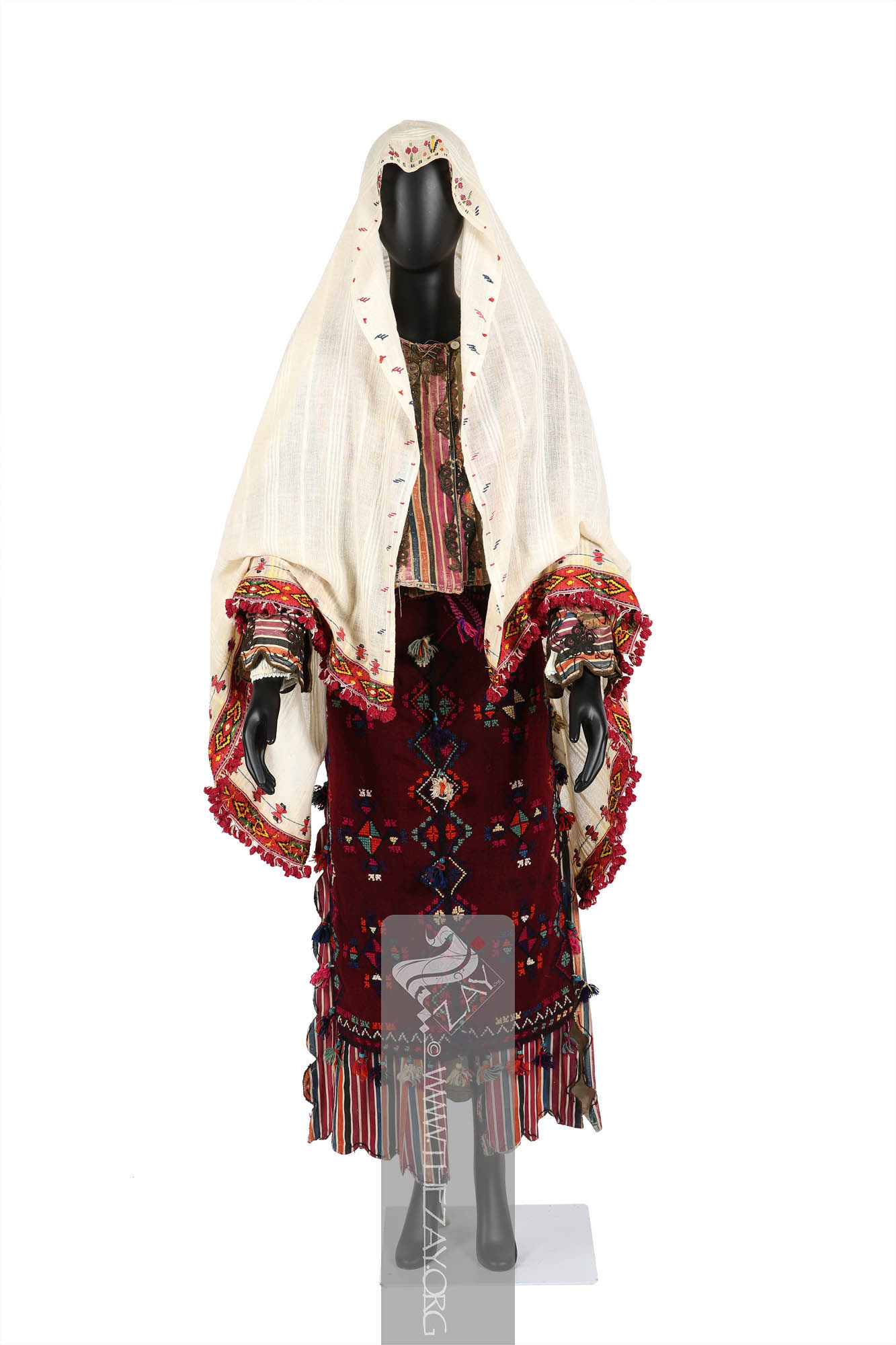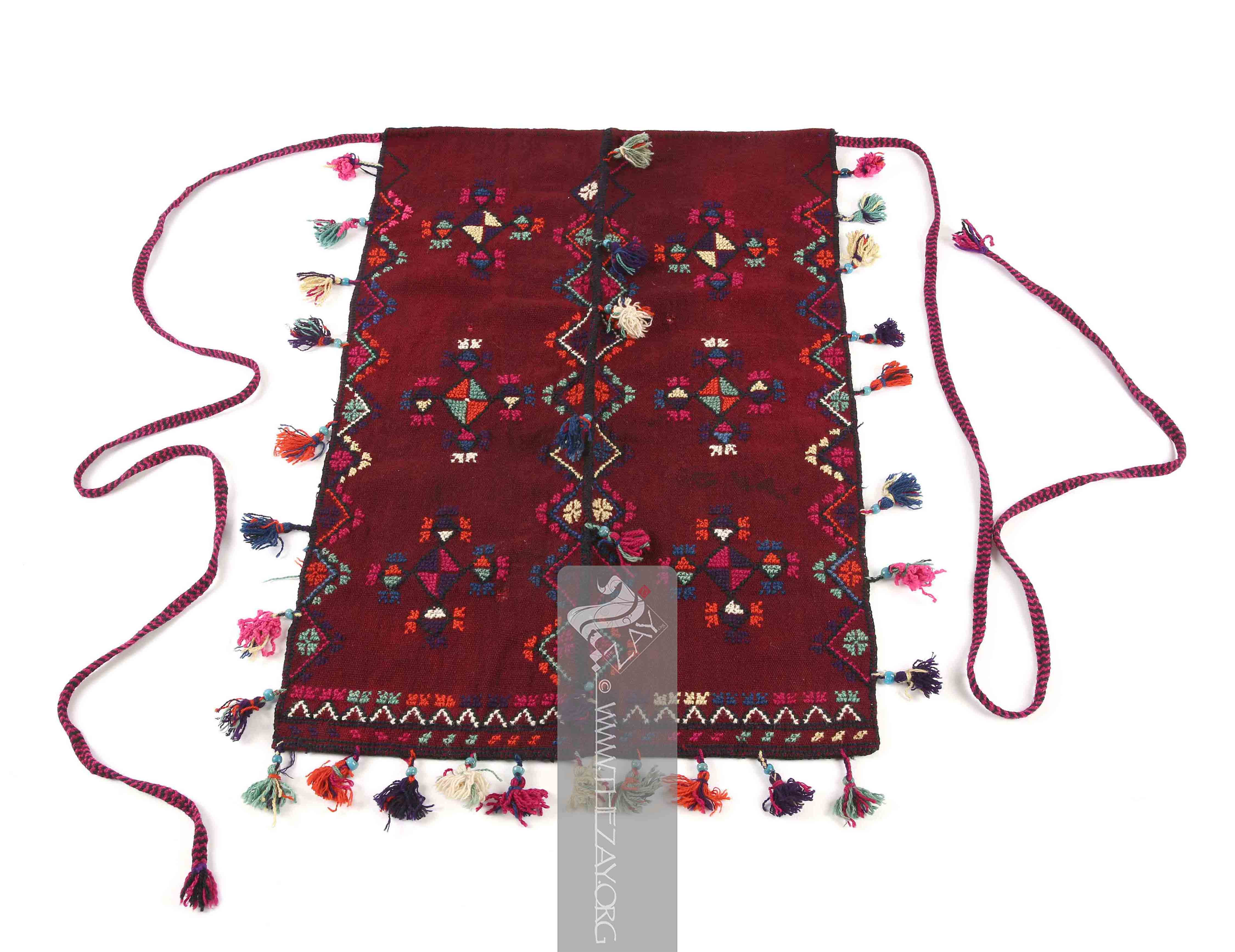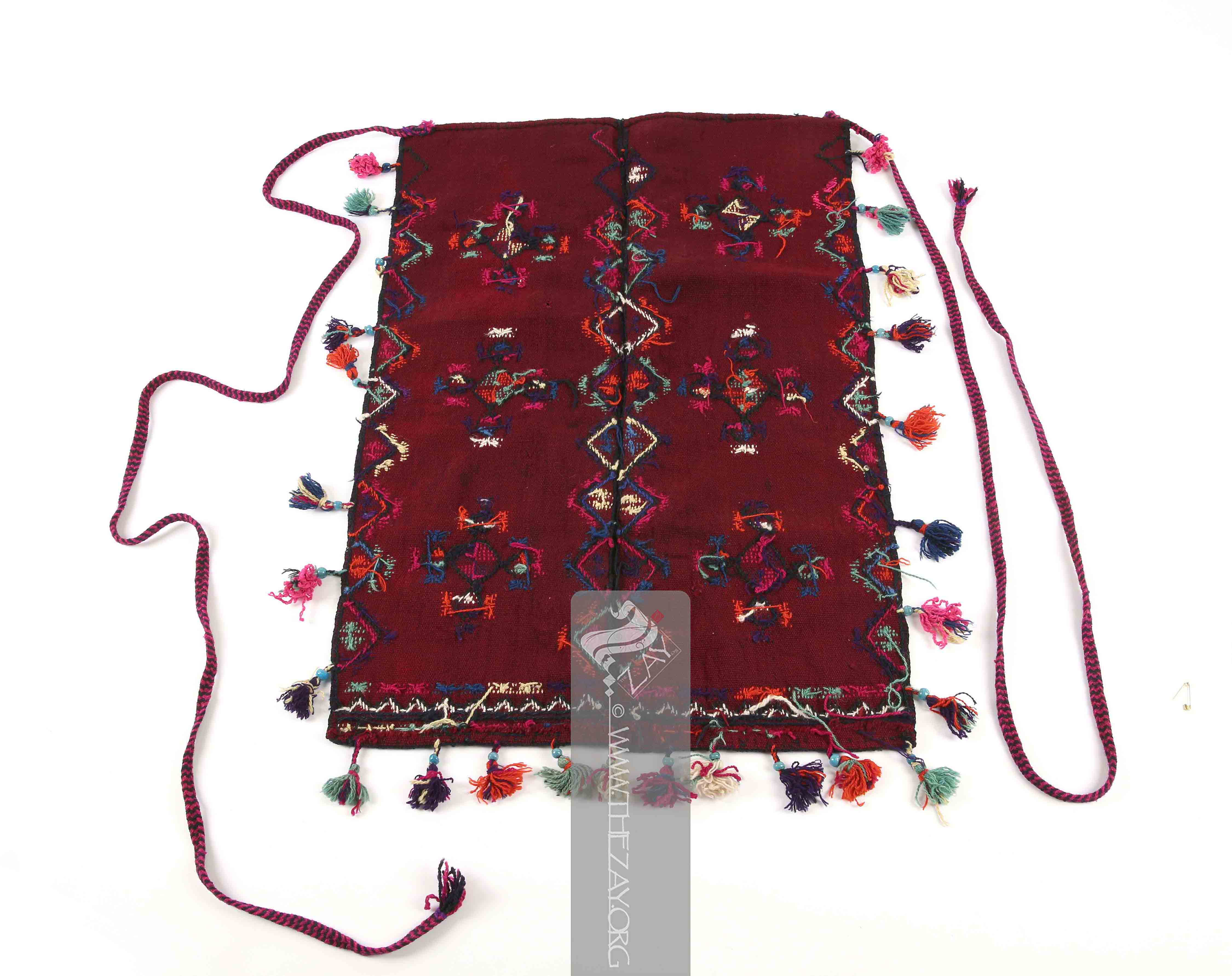Object NotePart of an ensemble with seven other pieces that are also part of the collection (
ZI2018.500640a ASIA,
ZI2018.500640b ASIA,
ZI2018.500640c ASIA,
ZI2018.500640d ASIA,
ZI2018.500640e ASIA,
ZI2018.500640d ASIA,
ZI2018.500640e ASIA).
Object History This piece of garment was purchased by
Dr. Reem Tariq
Ṭariq: (Arabic; Synonym: tulle_bi_talli
Tūlle_bi_tallī: (French: Tulle – a city in France where fine material for veil was first made; Turkish: tel – wire; Synonym: tariq; talli; badla; khus_dozi ), series of small metal knots made on a woven net ground as embellishment. The term is commonly used in the North African Arab region specifically in Egypt.
; talli; badla; khus_dozi ), series of small metal knots made on a woven net ground as embellishment. The term is commonly used in the Levant Arab region specifically in Lebanon.
El Mutwalli
Dr. Reem Tariq
Ṭariq: (Arabic; Synonym: tulle_bi_talli
Tūlle_bi_tallī: (French: Tulle – a city in France where fine material for veil was first made; Turkish: tel – wire; Synonym: tariq; talli; badla; khus_dozi ), series of small metal knots made on a woven net ground as embellishment. The term is commonly used in the North African Arab region specifically in Egypt.
; talli; badla; khus_dozi ), series of small metal knots made on a woven net ground as embellishment. The term is commonly used in the Levant Arab region specifically in Lebanon.
el Mutwallī: Founder (CEO) of the Zay
Zay: (Arabic: costume, Pl. azyaā’), a set of clothes in a style typical of a particular country or historical period. Initiative, a public figure, speaker and author. An expert curator and consultant in Islamic art and architecture, interior design, historic costume, and UAE heritage. as a set of ensembles from Jade Bréval, an independent collector from France in 2018 to add to and enhance The
Zay
Zay: (Arabic: costume, Pl. azyaā’), a set of clothes in a style typical of a particular country or historical period. Initiative collection.
Ms Jade Bréval who had travelled for over 15 years in and around Türkiye had collected items such as this from shops and individuals in small villages and towns that she visited.
Object Features This is a multicoloured wool embroidered apron (önlük) on a woven burgundy woollen base with beads, pompoms, and ribbon embellishments.
The field of the önlük is embroidered with orange, pink, blue, (
turquoise
Turquoise: (French: turquois – present day Türkiye; Synonyms: firuze, pheroza), is a naturally occurring opaque mineral mined in abundance in Khorasan province of Iran and has been used for making dye for centuries. The term is a derivative of the French word for the country Türkiye once called Turkey. ) blue /(
pheroza
: (Persian: pērōzah – "victory", later Arabic: fayrūz; Synonyms: firuze, turquoise
Turquoise: (French: turquois – present day Türkiye; Synonyms: firuze, pheroza), is a naturally occurring opaque mineral mined in abundance in Khorasan province of Iran and has been used for making dye for centuries. The term is a derivative of the French word for the country Türkiye once called Turkey. ), is a naturally occurring opaque mineral mined in abundance in Khorasan province of Iran and has been used for making dye for centuries. )/(
firuze
Firuze: (Persian: pērōzah – "victory", later Arabic: fayrūz; Synonyms: firuze, pheroza
: (Persian: pērōzah – "victory", later Arabic: fayrūz; Synonyms: firuze, turquoise
Turquoise: (French: turquois – present day Türkiye; Synonyms: firuze, pheroza), is a naturally occurring opaque mineral mined in abundance in Khorasan province of Iran and has been used for making dye for centuries. The term is a derivative of the French word for the country Türkiye once called Turkey. ), is a naturally occurring opaque mineral mined in abundance in Khorasan province of Iran and has been used for making dye for centuries. ), is a naturally occurring opaque mineral mined in abundance in Khorasan province of Iran and has been used for making dye for centuries. ), purple, black, and ivory wool featuring triangular, and rhombus geometric shapes executed with (
cross_stitch
Cross_stitch: A popular form of embroidery in which X-shaped stitches are used to create a design on fabric. It is a simple and versatile technique that can be used to create a wide range of patterns and designs and is commonly used in decorative and functional embroidery projects.) style embroidery.
A black embroidered panel divides the apron or önlük vertically in two halves with added pompoms and blue possibly wooden beads. Each side of the panel features a series of triangles encasing a floral pattern.
Similar elements are reflected in the two borders on the sides with pompoms of different coloured wool – pink, blue,
turquoise
Turquoise: (French: turquois – present day Türkiye; Synonyms: firuze, pheroza), is a naturally occurring opaque mineral mined in abundance in Khorasan province of Iran and has been used for making dye for centuries. The term is a derivative of the French word for the country Türkiye once called Turkey. , orange, white, and purple – with beads forming a decorative embellishment.
The bottom hemline is decorated in three tiers of geometric shapes and patterns as well as similar beads and pompoms hanging from the edge. The top corners have black and pink braided woollen ribbons attached for tying it around the waist of the wearer.
Although attributed to a special
tapestry
Tapestry: wall hanging or other large piece of fabric that is woven in coloured weft
Weft: one of the two basic components used in weaving that transforms thread or yarns into a piece of fabric. It is the crosswise thread on a loom that is passed over and under the warp threads. threads or embroidered with a decorative design. Typically made of wool, but they can also be made of other materials such as silk, linen, or cotton. Often used to decorate homes, churches, and other buildings. weave practiced by the Alevi Turkmen of the region by the previous collector, it was established upon closer perusal that the embellishments on the önlük were not woven but embroidered.
Irrespective of its region of origin or acquisition it is similar to the Balkan examples from the 19th and early 20th centuries, especially Romanian (
fota
Fota: (Ottoman Turkish: fota – Apron; from Classical Persian: futa – bath wrapper), an apron or a peasant’s skirt traditionally worn by Romanian women. It is a colourful and intricately embroidered apron, typically made of wool, linen or cotton. A symbol of cultural heritage it is worn on special occasions. ). Aprons such as these perhaps became common throughout the Ottoman Empire and particularly widespread in the north-western provinces, such as the Marmara region in present-day Türkiye, in the late 19th and early 20th centuries because of its sizeable Balkan population.
Interestingly, this kind of embroidered önlük also closely resembles the traditional Iraqi shoulder mantels (
charuga
Charuga: (Possibly Kurdish), a mantle-like embroidered women’s traditional garment from the Qaraqosh region in northern Iraq, traditionally fastened at the shoulder. Historically worn by field workers, it helped conceal dust and dirt, making them less visible during labour, it is a festive garment worn sparingly during festivals and other special occasions.
) (
ZI2022.500999.7 IRAQ and
ZI2022.500999.15 IRAQ) in its embellishment and design elements. Additionally, while the word
fota
Fota: (Ottoman Turkish: fota – Apron; from Classical Persian: futa – bath wrapper), an apron or a peasant’s skirt traditionally worn by Romanian women. It is a colourful and intricately embroidered apron, typically made of wool, linen or cotton. A symbol of cultural heritage it is worn on special occasions. which is derived from the classical Persian word for bath towel (
futa
Futa: (Classical Persian), a cloth used either as an apron or a bath wrapper ) means an apron, a similar sounding word in Arabic (
futah
Fūṭah: (Arabic, Classical Persian: futa – bath wrapper), a piece of cloth that either covers the head and/or the torso of a person. ) also derived from the same classical Persian word denotes any cloth that covers the head and the upper body.
At its peak, the Ottoman Empire spanned three continents and served as the crossroads between the East and the West – the Fertile Crescent, the Levant, Eastern Europe including the Balkans till the southern edge of the Great Hungarian Plain, Northern Africa, and Eastern Mediterranean.
After the conquest of the Arab world in c. 1516-1517 CE its control over the Middle East lasted for four centuries until the early 20th century with the onset of WW I and the Arab Revolt. These four hundred years witnessed many instances of mutual Arab and Ottoman cultural influences and exchanges. Through areas such as social life and art – decorative and performing –we come across several instances of Arab and Turkish culture blending together through the centuries.
Just as European fashion was often inspired by the French court this socio-cultural blending between Ottoman Turkey and the Middle East was clearly reflected in its fashion and material culture.
Thus, while emulating Ottoman fashion as the mark of class in the Arab world was one side of the puzzle adapting Eastern European fashion particularly Balkan as part of mainstream couture culture because of the sizeable Balkan population within the Empire was another. Therefore, it is not surprising to find several articles of clothing and their terms similar between the two cultures.
Links
- Cangsökçe, Hadiye, et al. Osmanlı İmparatorluğu’nun Son Döneminden Kadın Giysileri = Women’s Costume of the Late Ottoman Era from the Sadberk Hanım Museum Collection. Sadberk Hanım Museum, 2010.
- Küçükerman, Önder, and Joyce Matthews. The Industrial Heritage of Costume Design in Turkey. GSD Foreign Trade Co. Inc, 1996.
- AĞAÇ, Saliha, and Serap DENGİN. “The Investigation in Terms of Design Component of Ottoman Women Entari
: (Turkish; Synonym: Antari), a traditional Turkish long jacket-like unisex garment worn during the Ottoman era. It often featured an open front with long sleeves and was worn over an undershirt and a pair of trousers and was sometimes layered by a short waist or hip-length jacket. in 19th Century and Early 20th Century.” International Journal of Science Culture and Sport (IntJSCS), vol. 3, no. 1, Mar. 2015, pp. 113–125. https://dergipark.org.tr/tr/download/article-file/91778
- Parker, Julianne. “OTTOMAN AND EUROPEAN INFLUENCE IN THE NINTEENTH-CENTURY BRIDAL COLLECTION OF THE AZEM PALACE, DAMASCUS, SYRIA.” Journal of Undergraduate Research: Brigham Young University, 18 Sept. 2013. http://jur.byu.edu/?p=6014
- Koç, Adem. “The Significance and Compatibility of the Traditional Clothing-Finery Culture of Women in Kutahya in Terms of Sustainability.” Milli Folklor , vol. 12, no. 93, Apr. 2012. 184. https://www.millifolklor.com/PdfViewer.aspx?Sayi=93&Sayfa=181
- Micklewright, Nancy. “Late-Nineteenth-Century Ottoman Wedding Costumes as Indicators of Social Change.” Muqarnas, vol. 6, 1989, pp. 161–74. JSTOR, https://doi.org/10.2307/1602288. Accessed 13 July 2023.
- Micklewright, Nancy. “Looking at the Past: Nineteenth Century Images of Constantinople and Historic Documents.” Expedition, vol. 32, no. 1, pp. 24–32. https://www.penn.museum/documents/publications/expedition/pdfs/32-1/micklewright.pdf
- Ozgen, Ozlen, et al. “Henna Ritual Clothing in Anatolia from Past to Present: An Evaluation on Bindalli.” Textile Society of America Symposium Proceedings, 2021, https://doi.org/10.32873/unl.dc.tsasp.0122.
- Kaya, Ozlem, and Laura Sinziana Cuciuc Romanescu. “ROMANIAN FOLK SYMBOLS IN CONTEMPORARY FASHION DESIGN.” New Design Ideas, vol. 5, no. 2, pp. 135–149, https://doi.org/2021.
- https://eliznik.org.uk/traditions-in-bulgaria/traditional-clothing-in-bulgaria/womens-clothing-in-bulgaria/womens-aprons-and-tunics/womens-single-and-double-aprons/
- http://folkcostume.blogspot.com/2014/02/costume-and-embroidery-of-bukovyna-part.html
- http://www.folkwearsociety.com/knowledge/typology
- https://peasantartcraft.com/rural-romanian-lifestyle/romanian-national-costumes/
- https://www.pinterest.de/pin/21603273204100180/?mt=login
- https://www.pinterest.de/pin/2885187247382031/
- https://www.instagram.com/p/Cq7TjfLI79I/?img_index=1







